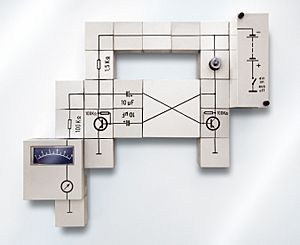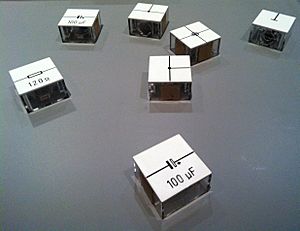Raytheon Lectron facts for kids
Lectron was a cool electronic kit that helped young people learn about how circuits work. It was like building with special blocks!
What is Lectron?
The Lectron kit had electronic parts inside special "building blocks." Each block had a clear bottom and a white top. On top, you could see a drawing of the electronic part inside, called a schematic. This drawing showed how the part worked.
These blocks had magnets on them. You could stick them onto a metal plate. This metal plate was a work surface and also connected everything to "ground." Ground is like a common return path for electricity.
Because of the magnets, you didn't need to solder (melt metal to join wires) or use a breadboard (a special board for testing circuits). This made it safe and easy to move the blocks around. You could quickly see how changing the blocks changed the circuit!
The instruction books showed you how to put the blocks together. They also explained what each part did in the circuit. You could start with simple projects, like making a light bulb turn on with a switch. Then you could build more complex things, like a radio with three transistors and a speaker!
The Lectron kits made by Raytheon haven't been sold in the US since 1969. But you can still buy Lectron products today! They are made in Frankfurt, Germany and can be shipped all over the world. Just know that the instruction manuals are in German.
Lectron's History
How Lectron Started in Europe
The Lectron electronic blocks were invented by Georg Greger in the early 1960s. He applied for a patent for his "electronic building blocks" in 1965. He received a German patent in 1967 and an American patent in 1969. The American patent papers have extra drawings and more details about how everything works.
The Lectron kit first came out in Germany through a company called Egger-Bahn, which made model trains. In 1967, Egger-Bahn stopped making Lectron. The product then moved to a new company called Deutsche Lectron GmbH. This company made Lectron until 1972.
Deutsche Lectron GmbH let other companies sell Lectron. Braun, a famous German company, sold Lectron everywhere except North America. In the United States, a company called Macalaster Scientific (part of Raytheon) sold the kits.
In 1967, Braun took over the Lectron line from Deutsche Lectron GmbH. They kept the basic block design and the styrofoam storage case. But Dieter Rams and his team at Braun redesigned the outside packaging and all the instruction manuals. They also added new parts to the Lectron system. For example, Dietrich Lubs, who designed the famous "round button" pocket calculator, created symbols for new "Demonstration System" parts. These were larger blocks used for teaching in classrooms.
In 1972, Braun separated from the Lectron business. It joined with Deutsche Lectron GmbH to form Lectron GmbH. Manfred Walter, who used to lead the Lectron department at Braun, became the owner. He kept developing new Lectron products. In 2001, he gave the business, all its parts, and manufacturing tools to Reha Werkstatt Oberrad. This is a non-profit business that creates jobs for people with disabilities. RWO continues to make and improve Lectron today.
From 1967 to 1972, an Italian company called INELCO sold Braun Lectron kits in Italy. After 1972, INELCO sold its own Lectron sets called "Sistema Lectron Serie 2000." From 1968 to 2001, INELCO also translated the German manuals for Braun and Lectron GmbH into seven other languages.
Lectron in North America
Raytheon sold Lectron in North America in two main ways. The first version was called "Electronic Dominoes." It had two models: the 800 and the 820.
The second version started in May 1968 and was simply called "Lectron." This version added three new sets. The old 800 and 820 models were renamed Series 2 and Series 3, and their packaging was redesigned. This new Lectron line included Series 1 through 5 models and Add-On Kits 1 through 5. These kits let you upgrade a smaller set, like a Series 1, into a larger one, like a Series 2. The name "Electronic Dominoes" was no longer used.
Raytheon reused the styrofoam molds from the original Egger packaging, but they used white styrofoam instead of black. The blocks themselves were still made in West Germany. Later, the Series 3A came out, offering 64 different experiments. Add-On Kits 6 and 7 were also released around the same time as the Series 3A. Raytheon also sold a special Series 3 model for a company called Creative Playthings. This version was called the 'S822 Lectron SCIII'.



